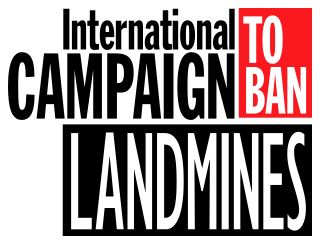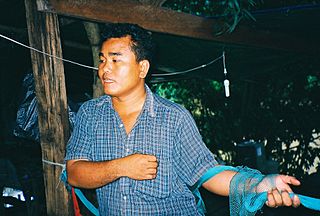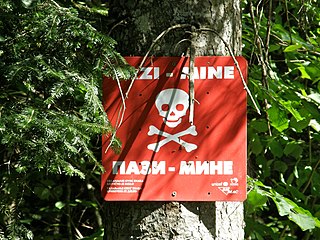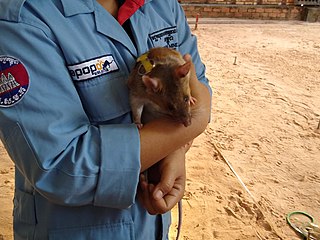
A land mine, or landmine, is an explosive weapon concealed under or camouflaged on the ground, and designed to destroy or disable enemy targets, ranging from combatants to vehicles and tanks, as they pass over or near it.

The International Campaign to Ban Landmines (ICBL) is a coalition of non-governmental organizations whose stated objective is a world free of anti-personnel mines and cluster munitions, where mine and cluster munitions survivors see their rights respected and can lead fulfilling lives.

The HALO Trust is a humanitarian non-government organisation which primarily works to clear landmines and other explosive devices left behind by conflicts. With over 10,000 staff worldwide, HALO has operations in 28 countries. Its largest operation is in Afghanistan, where the organization continues to operate under the Taliban regime that took power in August 2021.

Unexploded ordnance, unexploded bombs (UXBs), and explosive remnants of war are explosive weapons that did not explode when they were employed and still pose a risk of detonation, sometimes many decades after they were used or discarded. When unwanted munitions are found, they are sometimes destroyed in controlled explosions, but accidental detonation of even very old explosives also occurs, sometimes with fatal results. A dud is an unexploded projectile fired in anger against an enemy, but which has failed to explode. A projectile not fired in anger but which has failed to explode is called a 'blind'.

Demining or mine clearance is the process of removing land mines from an area. In military operations, the object is to rapidly clear a path through a minefield, and this is often done with devices such as mine plows and blast waves. By contrast, the goal of humanitarian demining is to remove all of the landmines to a given depth and make the land safe for human use. Specially trained dogs are also used to narrow down the search and verify that an area is cleared. Mechanical devices such as flails and excavators are sometimes used to clear mines.

Minefields in Croatia cover 258.00 square kilometres of territory. As of 2020, the minefields are located in 45 cities and municipalities within 8 counties. These areas are thought to contain approximately 17,285 land mines, in addition to unexploded ordnance left over from the Croatian War of Independence. Land mines were used extensively during the war by all sides in the conflict; about 1.5 million were deployed. They were intended to strengthen defensive positions lacking sufficient weapons or manpower, but played a limited role in the fighting.
A mine clearance organization, or demining organization, is an organization involved in the removal of landmines and unexploded ordnance (UXO) for military, humanitarian, or commercial reasons. Demining includes mine clearance, as well as surveying, mapping and marking of hazardous areas.

Aki Ra is a former Khmer Rouge conscripted child soldier who works as a deminer and museum curator in Siem Reap, Cambodia. He has devoted his life to removing landmines in Cambodia and to caring for young landmine victims. Aki Ra states that since 1992 he has personally removed and destroyed as many as 50,000 landmines, and is the founder of the Cambodian Landmine Museum.

The Gambian pouched rat, also commonly known as the African giant pouched rat, is a species of nocturnal pouched rat of the giant pouched rat genus Cricetomys, in the family Nesomyidae. It is among the largest muroids in the world, growing to about 0.9 m (3 ft) long, including the tail, which makes up half of its total length. It is widespread in sub-Saharan Africa, ranging from Senegal to Kenya and from Angola to Mozambique from sea level to 2,000 m (6,600 ft).
Mine action is a combination of humanitarian aid and development studies that aims to remove landmines and reduce the social, economic and environmental impact of them and the explosive remnants of war (ERW).

The Mines Advisory Group (MAG) is a non-governmental organization that assists people affected by landmines, unexploded ordnance, and small arms and light weapons.
Ly Thuch (Khmer: លី ធុជ) is a Cambodian politician who serves as the Senior Minister. He belongs to the Cambodian People's Party and was elected to represent Pursat Province in the National Assembly of Cambodia in 2003.

Land mine contamination in Bosnia and Herzegovina is a serious aftereffect of the Bosnian War, which took place from 1992 until 1995. During this time period, all 3 conflicting factions planted land mines near the current-day political entity borders. As a result, the country has had the most severe land mine problems in the world. Although landmine removal efforts have made progress throughout the country and the landmine-related deaths have steadily decreased each year, many people are still killed or suffer injuries caused by unexploded munitions in Bosnia and Herzegovina. Despite the threat of landmines, people enter contaminated areas out of economic necessity.

APOPO is a registered Belgian non-governmental organisation and US non-profit which trains southern giant pouched rats to detect landmines and tuberculosis. They call their trained rats 'HeroRATs'.

The United Nations Mine Action Service (UNMAS) is a service located within the United Nations Department of Peacekeeping Operations that specializes in coordinating and implementing activities to limit the threat posed by mines, explosive remnants of war and improvised explosive devices.
Cambodian Self Help Demining (CSHD) is a nonprofit NGO founded by Aki Ra in Cambodia. Its mission is to clear landmines and UXOs in 'low priority' villages throughout the Kingdom of Cambodia. Low priority villages are often villages in remote area with limited traffic and populated by poor farmers. Hence, they do not receive priority from mine clearance projects and are at times overlooked.
Gender mainstreaming in mine action is the application of gender mainstreaming to mine action. It is increasingly being adopted by international and state mine action organizations.

Prak Sokhonn is a Cambodian politician, diplomat and journalist who served in the Cabinet of Cambodia as Minister of Foreign Affairs of Cambodia from 2016 to 2023, and Deputy Prime Minister of Cambodia from 2018 to 2023.

ITF Enhancing Human Security is a humanitarian, non-profit organization founded by the Republic of Slovenia., which specializes in land mine clearance and post-conflict reconstruction. It was established on 12 March 1998 with the purpose of helping Bosnia and Herzegovina in its post-conflict rehabilitation, specifically with mine clearance and assistance to mine victims.

Magawa was a Gambian pouched rat that worked as a HeroRAT sniffing out landmines in Cambodia for the non-governmental organization APOPO which trains rats to detect landmines and tuberculosis. Magawa was the most successful landmine-sniffing rat in the organization's history, and received the PDSA Gold Medal in 2020.
















